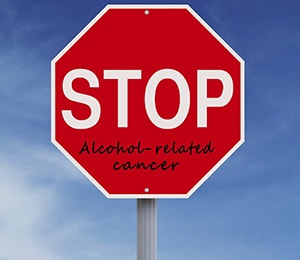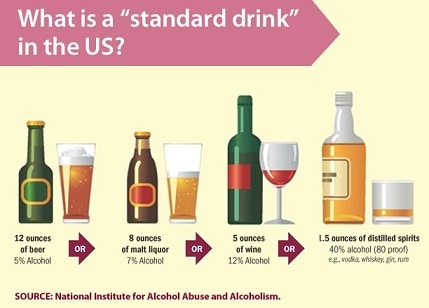Preventing Cancer by Reducing Excessive Alcohol Use

Excessive alcohol use is associated with many health and social problems, including cancer.
More than half of adults in the United States drink alcohol.1 Alcohol use increases the risk of cancers of the female breast, liver, colon, rectum, mouth, pharynx, larynx, and esophagus.2,3,4 There are evidence-based community strategies5 and clinical strategies6 that work to reduce excessive alcohol use.
Cancer Risks Linked with Alcohol Use
Excessive alcohol use is associated with many health and social problems. Alcohol is a carcinogen (something that can cause cancer).2,3,4 Regardless of drink type (beer, wine, or liquor), the risk of cancer increases with the number of drinks consumed, and even one drink a day increases the risk of developing cancers of the female breast, mouth, and esophagus.3 Reducing alcohol use may reduce the risk of cancer.7
How Is Alcohol Use Defined?
Moderate alcohol use is defined as consuming up to one drink per day for women and up to two drinks per day for men.
Excessive alcohol use includes binge drinking, heavy drinking, any alcohol use by individuals under the age of 21 years (minimum legal drinking age), and any alcohol use by pregnant women.
Binge drinking is a pattern of alcohol use that brings blood alcohol concentration levels to 0.08% or more. This is usually defined as consuming four drinks or more for women and five drinks or more for men on a single occasion, generally within about two hours.
Heavy drinking is defined as consuming eight drinks or more per week for women and 15 drinks or more per week for men.

What Are the Guidelines for Alcohol Use?
According to the Dietary Guidelines for Americans,8—
- If you choose to drink, do so in moderation—up to one drink a day for women or up to two drinks a day for men.
- Don’t drink at all if you are younger than age 21, pregnant or may be pregnant, have health problems that could be made worse by drinking, or are engaging in activities for which alcohol is dangerous (like driving).
- The Guidelines also do not recommend that you start drinking for any reason. Even moderate intake is associated with increased risks, including some cancers.
Community strategies can help communities create social and physical environments that prevent excessive alcohol use.
Health care providers can screen adults for excessive alcohol use to identify people whose levels or patterns of alcohol use place them at increased risk of alcohol-related harms.
To address alcohol as a risk factor for cancer, comprehensive cancer control programs can start or continue important activities to help reduce excessive alcohol use in their communities.
This list of potential partners and sources provides information to help comprehensive cancer control coalitions reduce excessive alcohol use in their communities.
References
1Centers for Disease Control and Prevention. Behavioral Risk Factor Surveillance System Prevalence and Trends Data, 2017. https://www.cdc.gov/brfss/brfssprevalence/. Accessed September 4, 2019.
2International Agency for Research on Cancer. IARC Monographs on the Evaluation of Carcinogenic Risks to Humans: Volume 96: Alcohol Consumption and Ethyl Carbamate. Lyon, France: International Agency for Research on Cancer; 2010.
3International Agency for Research on Cancer. IARC Monographs on the Evaluation of Carcinogenic Risks to Humans: Volume 100E: Personal Habits and Indoor Combustions. Lyon, France: International Agency for Research on Cancer; 2012.
4Boffetta P, Hashibe M. Alcohol and cancer. Lancet Oncology 2006;7(2):149–156.
5Community Preventive Services Task Force. Guide to Community Preventive Services: Preventing Excessive Alcohol Consumption. Accessed September 4, 2019.
6U.S. Preventive Services Task Force. Unhealthy Alcohol Use in Adolescents and Adults: Screening and Behavioral Counseling Interventions. November 2018.
7World Cancer Research Fund / American Institute for Cancer Research. Food, Nutrition, Physical Activity, and the Prevention of Cancer: A Global Perspective. Washington, DC: AICR; 2007.
8U.S. Department of Health and Human Services and U.S. Department of Agriculture. 2015–2020 Dietary Guidelines for Americans. 8th Edition. Washington, D.C.: U.S. Department of Health and Human Services; 2015.

























.jpg)












No hay comentarios:
Publicar un comentario